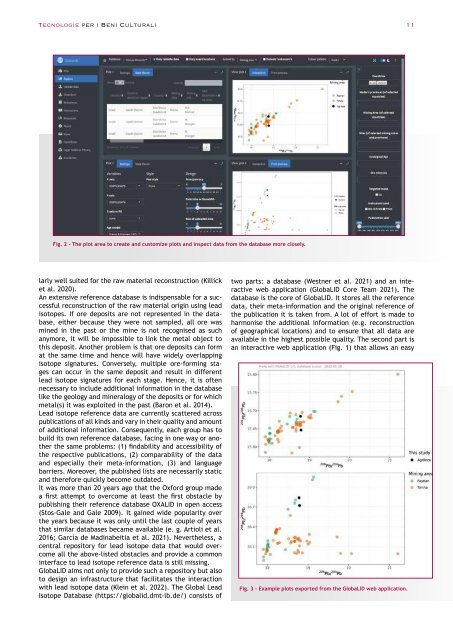Archeomatica_1_2022
GIGAPIXEL ALLA GALLERIA NAZIONALE DELL'UMBRIA
GIGAPIXEL ALLA GALLERIA NAZIONALE DELL'UMBRIA
Create successful ePaper yourself
Turn your PDF publications into a flip-book with our unique Google optimized e-Paper software.
Tecnologie per i Beni Culturali 11<br />
Fig. 2 - The plot area to create and customize plots and inspect data from the database more closely.<br />
larly well suited for the raw material reconstruction (Killick<br />
et al. 2020).<br />
An extensive reference database is indispensable for a successful<br />
reconstruction of the raw material origin using lead<br />
isotopes. If ore deposits are not represented in the database,<br />
either because they were not sampled, all ore was<br />
mined in the past or the mine is not recognised as such<br />
anymore, it will be impossible to link the metal object to<br />
this deposit. Another problem is that ore deposits can form<br />
at the same time and hence will have widely overlapping<br />
isotope signatures. Conversely, multiple ore-forming stages<br />
can occur in the same deposit and result in different<br />
lead isotope signatures for each stage. Hence, it is often<br />
necessary to include additional information in the database<br />
like the geology and mineralogy of the deposits or for which<br />
metal(s) it was exploited in the past (Baron et al. 2014).<br />
Lead isotope reference data are currently scattered across<br />
publications of all kinds and vary in their quality and amount<br />
of additional information. Consequently, each group has to<br />
build its own reference database, facing in one way or another<br />
the same problems: (1) findability and accessibility of<br />
the respective publications, (2) comparability of the data<br />
and especially their meta-information, (3) and language<br />
barriers. Moreover, the published lists are necessarily static<br />
and therefore quickly become outdated.<br />
It was more than 20 years ago that the Oxford group made<br />
a first attempt to overcome at least the first obstacle by<br />
publishing their reference database OXALID in open access<br />
(Stos-Gale and Gale 2009). It gained wide popularity over<br />
the years because it was only until the last couple of years<br />
that similar databases became available (e. g. Artioli et al.<br />
2016; García de Madinabeitia et al. 2021). Nevertheless, a<br />
central repository for lead isotope data that would overcome<br />
all the above-listed obstacles and provide a common<br />
interface to lead isotope reference data is still missing.<br />
GlobaLID aims not only to provide such a repository but also<br />
to design an infrastructure that facilitates the interaction<br />
with lead isotope data (Klein et al. <strong>2022</strong>). The Global Lead<br />
Isotope Database (https://globalid.dmt-lb.de/) consists of<br />
two parts: a database (Westner et al. 2021) and an interactive<br />
web application (GlobaLID Core Team 2021). The<br />
database is the core of GlobaLID. It stores all the reference<br />
data, their meta-information and the original reference of<br />
the publication it is taken from. A lot of effort is made to<br />
harmonise the additional information (e.g. reconstruction<br />
of geographical locations) and to ensure that all data are<br />
available in the highest possible quality. The second part is<br />
an interactive web application (Fig. 1) that allows an easy<br />
Fig. 3 - Example plots exported from the GlobaLID web application.


















